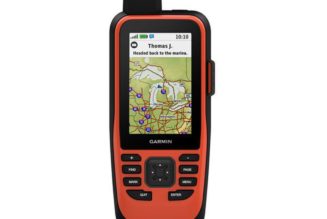I have been a technology cheapskate most of my life. I’ve rarely bought a monitor brand-new; I’m pleased to say I pieced together my current three-screen articulating swing-arm setup primarily from Craigslist and hand-me-downs. But this fall, I had an opportunity to temporarily replace my three aging displays with the most ridiculous, most advanced gaming monitor ever made: the super-ultrawide, super-curved, ultra-high resolution 49-inch Samsung Odyssey G9.
The Samsung Odyssey G9 is a monitor so big, so wide, so curved, it can fill a midsized desk and wrap around your entire field of view. It’s also simply a phenomenal screen: speedy (240Hz, 1ms, G-Sync, and FreeSync 2), high resolution (5120 x 1440-pixel), and bursting with brilliant color thanks to a QLED panel that tops out at an eye-searing 1,000 nits of brightness. I’m not kidding when I say I have to avert my eyes when I launch Destiny 2 in HDR, and I could swear I felt the flames the first few times my Star Wars: Squadrons’ TIE Bomber blasted an X-Wing into oblivion.
As they say on Reddit, I have ascended — and the past few weeks have been a gaming and productivity experience like few I’ve had before.
But gradually, I’ve been coming back down to Earth.
Design
The Odyssey G9 is a showstopper, and I don’t just mean that figuratively: last January, attendees of the world’s biggest technology show were dazzled by its unprecedented curvature and sci-fi inspired frame.
When I put that same monitor on my humble IKEA sit-stand desk, the effect is otherworldly. Compared to my old hodgepodge of screens and rat’s nest of cabling, this G9 looks like a terminal aboard a Star Trek spaceship… even if my physical keyboard and its long braided cable ruin the illusion a bit.
The sheer size of the Odyssey G9 and its broad-shouldered stand do limit your options. I’m lucky that my small-form-factor Ncase M1 can fit behind the screen, and there’s just enough clearance (a little over six inches) for my Audioengine A2+ speakers to fit underneath the monitor at the stand’s highest position. But if I had a bigger PC or bigger speakers, I might have also needed a bigger desk — or else had to use the included 100mm x 100mm VESA adapter to mount the nearly four-feet wide, one-foot deep, 31-pound screen to the wall. My current monitor arms can’t carry nearly that much weight, though you can buy some TV arms that do.
As it is, I’m a fan of the way this monitor brings my whole desk together. Two DisplayPorts and an HDMI 2.0 port let me switch between three video sources easily, including a side-by-side mode which lets me display two at once, effectively giving my PC and game console (or a second computer) each their own 27-inch, 2560 x 1440 displays.
There’s also a two-port USB-A 3.0 hub and a 3.5mm audio output, which worked perfectly with my keyboard’s USB and 3.5mm audio passthrough. As you can see from my photos, I can do a lot with only a single visible cable thanks to those ports. And while the narrow V-shaped stand might seem a little minimal for a monitor this hefty, it takes a decent shove to get it to tip forward even at its highest position.
:no_upscale()/cdn.vox-cdn.com/uploads/chorus_asset/file/22067624/20201012_Sean_Hollister_Verge_1.jpg)
:no_upscale()/cdn.vox-cdn.com/uploads/chorus_asset/file/22026736/shollister_201031_42850043.0.jpg)
:no_upscale()/cdn.vox-cdn.com/uploads/chorus_asset/file/22026734/shollister_201031_42850044.0.jpg)
You can adjust the monitor’s settings using a tiny five-way control nub underneath the power LED, and it’s remarkable how much you can tweak — including the ability to crop the entire panel to 4:3, 16:9, or 21:9 aspect ratios instead of stretching out the image. You can effectively have a 27-inch HDR panel for your game console or TV whenever you need. It’s just a shame that the monitor’s biggest benefits don’t necessarily translate to its side-by-side mode, where your 240Hz HDR screen generally becomes a pair of 60Hz SDR ones.
Productivity
My first big test for Samsung’s Odyssey G9 wasn’t a console or even PC gaming — last month, I co-hosted The Verge’s industry-famous Apple event live blog, capturing every screenshot you saw. I normally run three monitors because I switch tasks like mad, and if there’s a better multitasking test than an Apple event, I haven’t met it yet.
:no_upscale()/cdn.vox-cdn.com/uploads/chorus_asset/file/22026735/shollister_201031_42850042.0.jpg)
At first, I wasn’t sure this epic screen would work. Most apps and websites aren’t designed to display across the vast expanse of a single 32:9 monitor, so you have to live in windows. I couldn’t simply toss one or two apps onto each monitor like I usually do. But while Samsung doesn’t ship the G9 with any good windowing software and Windows 10’s default Snap is woefully insufficient, Microsoft’s free downloadable FancyZones windowing manager worked wonders.
l built my own set of dedicated snappable spots for the Apple live stream; The Verge’s live-blogging tool; Slack; a browser window to keep track of any Apple press releases that might pop during the show; and even a narrow strip of Windows Explorer so I could see which images I’d already captured and weed them out as necessary. The only other wrinkle was the additional Chrome extension I had to download to ensure YouTube could launch “full screen” in a browser window, instead of taking over my entire ultrawide monitor.
In general, while I did occasionally miss my two vertically oriented monitors for scrolling long webpages, Google Docs, and Tweetdeck, I found the G9’s gigantic horizontal expanse of real estate nearly as effective for most tasks. Where I could only squeeze four narrow columns of Tweetdeck onto my old portrait-orientation screens, the G9 would comfortably fit five, plus a 30-tab web browser, a nice vertical strip of Evernote for note-taking, and our Slack newsroom alongside.
:no_upscale()/cdn.vox-cdn.com/uploads/chorus_asset/file/22026742/shollister_201031_42850021.0.jpg)
I wouldn’t say it’s better than having three screens for work, but it seems like a sufficient substitute — except maybe that toast notifications now pop up in the corner of my eye where they’re pretty easy to miss. Still, it’s nice not to have to match color, contrast, and brightness across three screens at a time, or adjust how my mouse crosses from one monitor to the next. Having a single, vast, unbroken expanse of real estate that’s always the same distance from my face (as I spin in my chair) is an absolute treat. And while the Odyssey G9’s unprecedented curve does tend to catch ambient light, the matte screen does a great job of diffusing any glare.
The ultrawide aspect ratio didn’t work as well for video as I hoped, though. While you might imagine 32:9 being great for movies, I had a hard time finding anything I could play in ultra high definition that wasn’t 16:9. Most streaming platforms won’t easily let you access their 4K and HDR content on a Windows machine to begin with — YouTube’s the primary exception, though Netflix works if you’ve got a recent Intel processor and use Microsoft Edge or the native app — and you’ll want 4K to take advantage of a screen this high-res and this close to your face. The 4K YouTube videos I played were definitely clearer than 1080p — I could really peep these pixels in Dieter’s iPhone 12 video review. And while standard 16:9, 1080p content does display just fine full-screen with black borders on the sides, it feels like I’m wasting a lot of screen real estate that way. Plus, the blacks are a bit gray, not the deep inky black you’d get from an OLED screen — particularly with HDR on and Samsung’s iffy local dimming enabled.
Gaming
The first thing you should know about gaming on the Odyssey G9 is that you’ll want a serious graphics card to go with it. Technically, 5120 x 1440 resolution isn’t quite as many pixels as a 3840 x 2160 4K UHD screen… but remember we’re also talking about a monitor that goes up to 240Hz. To properly review the Odyssey G9, I borrowed an Nvidia GeForce RTX 3080 to get enough horsepower, since my GTX 1080 couldn’t even run games like Death Stranding or Destiny 2 at 60fps smoothly at that resolution.
The second thing you should know about gaming on the Odyssey G9 is that it may not be quite as immersive as you’re imagining.
Don’t get me wrong: having an X-Wing cockpit wrapped all around you is an epic experience, and it feels like a true advantage to be able to use my peripheral vision in competitive shooters like PUBG and CS:GO. But it wasn’t long until I noticed something weird going on.
:no_upscale()/cdn.vox-cdn.com/uploads/chorus_asset/file/22067625/32_9_star_wars_squadrons_hangar.jpg)
:no_upscale()/cdn.vox-cdn.com/uploads/chorus_asset/file/22067628/Screenshot__25_.png)
Look carefully at these images: notice how the sides are warped? Imperial deck officers and Novigrad Temple Guards aren’t generally this pudgy.
I tried game after game after game on the Odyssey G9, digging into my Steam, Epic, and Uplay libraries and tweaking a variety of settings, and this is simply the reality: every 3D game gets warped when you’re viewing it in a 32:9 aspect ratio, and there’s not much you can do about it. Changing your field of view in a game doesn’t get rid of the effect; it simply changes how much of the game world appears in the center of your screen (where things look normal) and at the edges (where they look stretched and zoomed). I actually pulled out a tape measure and checked: video game content that measures 4.75 inches at the center of the display can get stretched to a full 12 inches at the edges.
Now, this isn’t Samsung’s fault; it’s just the way games are built. Most games have a single virtual camera that exists at a single point in space, and while Nvidia once proposed changing that (see link above), the company’s Simultaneous Multi-Projection doesn’t seem to have made it into any of the games I tested. And in games with pre-rendered cutscenes, like Final Fantasy XV, you’ll be watching them at their original aspect ratio.
But before you write off 32:9 ultrawides right now, there are three things I’d like you to consider:
- You might get used to it.
- It’s not that distracting in some games!
- 2D games aren’t affected at all.
Let me give you some examples.
:no_upscale()/cdn.vox-cdn.com/uploads/chorus_asset/file/22067630/pubg_32_9.jpg)
:no_upscale()/cdn.vox-cdn.com/uploads/chorus_asset/file/22067634/CS_go_32_9.jpg)
CS:GO and PUBG are incredibly competitive, nail-biting games where focus is everything, where you always need to have your gun at the ready and be scanning for any sign of movement. I don’t have time to turn my head left and right to appreciate the scenery or think about whether it’s warped. The G9 simply gives me enhanced peripheral vision, and it helps — not hurts — that things which appear in the corner of my eye are zoomed in by default. I got used to treating it as my peripheral vision and nothing else. (The 240Hz also comes in pretty handy in games like CS:GO where you can actually hit that frame rate.)
:no_upscale()/cdn.vox-cdn.com/uploads/chorus_asset/file/22067633/GenshinImpact_RKEDElbqFg.jpg)
:no_upscale()/cdn.vox-cdn.com/uploads/chorus_asset/file/22067632/bioshock_infinite_32_9.jpg)
Genshin Impact, Abzû, Rocket League, and BioShock Infinite are games with gorgeous, colorful worlds whose proportions aren’t “normal” to begin with, and I love having them wrapped around me.
:no_upscale()/cdn.vox-cdn.com/uploads/chorus_asset/file/22067635/xcom_2_32_9.jpg)
In Destiny 2 and XCOM 2, I found I could forgive the warping because of the enhanced field of view and the ability to easily zoom whenever you want. It’s nice to see more of the battlefield at once in XCOM while planning out how my soldiers will move each turn, and it’s pretty cool to aim down the sights in Destiny without the typical claustrophobia that comes with zooming in, since you’re still able to see what’s going on around you.
:no_upscale()/cdn.vox-cdn.com/uploads/chorus_asset/file/22067637/Worms_W.M.D_6ZejzXw2gF.jpg)
:no_upscale()/cdn.vox-cdn.com/uploads/chorus_asset/file/22067638/disco_elysium_21_9.jpg)
2D / 2.5D games like Worms W.M.D and Disco Elysium do look fantastic on the G9 — when you can find ones that actually support an ultrawide screen. That’s not a given: I managed to launch Soldat at 5120 x 1440 resolution, but it didn’t stretch across my monitor. Games with fixed widths like Streets of Rage 4 and Hyper Light Drifter won’t either. Even Disco Elysium only offers 21:9 support, not 32:9, unless you apply a hack.
:no_upscale()/cdn.vox-cdn.com/uploads/chorus_asset/file/22067639/Borderlands3_DXlFm6diiE.jpg)
And for every one of the 3D games that worked, I also found a Borderlands 3 or The Witness or Goat of Duty or The Witcher 3 where the warped geometry really bugged me, either because I wanted to sit back and look at the beautiful vista or because the edges of my screen were moving faster than the center.
That’s not easy to show you in still images, so here’s a video clip to show you what I mean:
[embedded content]
In games like the hack-and-slash Mordhau or the road-tripping Final Fantasy XV, the distraction can also be when a piece of geometry that’s critical to the game constantly looks wrong. (Your Mordhau sword or axe often extends into the warped area of the screen; the road itself in FFXV looks curved instead of flat!)
Frankly, the most annoying game I played on the Odyssey G9 was figuring out which games would work in the first place. Here, I have to shout out Rock Paper Shotgun’s Katharine Castle, whose brilliant example-filled guide showcases nearly three dozen titles that do work, complete with GIFs so you can see for yourself. But if you’re willing to work at it (and understand the risks), a community at the Widescreen Gaming Forum (WSGF) and PCGamingWiki can help you hack and patch many existing titles to work at 32:9, too.
:no_upscale()/cdn.vox-cdn.com/uploads/chorus_asset/file/22067641/death_stranding_32_9.jpg)
For instance, I installed a trainer that let me run Death Stranding at full-resolution 32:9, with an infinitely adjustable field of view, instead of the 21:9 that designer Hideo Kojima and company shipped.
:no_upscale()/cdn.vox-cdn.com/uploads/chorus_asset/file/22067644/persona_4_golden.jpg)
Using a common tutorial, I hex-edited my Persona 4 Golden .exe and remarkably wound up playing what was originally a 480p PlayStation 2 game — and later a 720p, 16:9 PlayStation Vita game — at a glorious 3840 x 1080 at 32:9. (I do still need to figure out how to un-stretch the UI.) And there’s an old, unmaintained program called Widescreen Fixer that helped me revisit an old favorite:
:no_upscale()/cdn.vox-cdn.com/uploads/chorus_asset/file/22067643/MirrorsEdge_PQpIN3VMLk.jpg)
:no_upscale()/cdn.vox-cdn.com/uploads/chorus_asset/file/22067642/MirrorsEdge_TgcxYDob1j.jpg)
I wouldn’t say the community is robust enough that you could necessarily find a fix for any game in your library. But the WSGF does now have a Discord you might want to check out.
The ultimate ultrawide, but the best monitor?
The Samsung Odyssey G9 costs $1,479.99 — a premium price for a premium monitor like nothing else on the market. You can find other 49-inch 32:9 panels for less, but none with this combination of resolution, brightness, curvature, and refresh rate. The closest you can come is last year’s $1,200 Samsung CRG9 which maintains the resolution and brightness but with half the refresh rate at 120Hz and a notably less pronounced 1800R curvature — which, I imagine, wouldn’t be as good at giving you convincing peripheral vision in games.
If you’re looking for the ultimate ultrawide, this is currently it. I’m just not convinced that I am, personally, even if I had that much money earmarked for a new screen. For $1,500 and the enormous amount of space the Odyssey G9 consumes, I could buy a 48-inch LG OLED TV instead. I’d get a screen just as gigantic for my multitasking, but taller, with 120Hz G-Sync and FreeSync support, incredibly deep blacks, HDMI 2.1 for variable refresh rate for the PS5 and Xbox Series X, and no need to troubleshoot aspect ratios for my videos and games. Linus Tech Tips has a video that dives deep into the pros and cons of that LG screen, and I came away fairly convinced.
It wouldn’t be the same experience that the G9 offers, of course, and I might regret it if Nvidia and AMD ever dust off Simultaneous Multi-Projection for real. The TV might also cut off access to a large portion of my desk, and I might not be able to place my PC and speakers within easy reach without blocking a bit of the screen. But I’d have a more obviously future-proof setup; an equally, if not more gorgeous image; and a lot less ambient annoyance when I want to game. At the very least, here’s hoping Samsung adds HDMI 2.1 to this epic monitor next year.
Photography and screenshots by Sean Hollister / The Verge
Correction: An earlier version of this review said splitting the screen into two 16:9 displays was the equivalent to two 24.5-inch monitors. It is more like two 27-inch monitors. We regret the error.










